Kotilingeshwara Temple Karnataka: 108 Ft Massive Lingam in the world
The Kotilingeshwara Temple in Karnataka, India, is a relatively new temple, having been constructed in 1980 by Swami Sambha Shiva Murthy. The temple is dedicated to Lord Shiva and is notable for its massive lingam, which is the tallest in the world at 108 feet (33 meters). The temple also houses over 90 lakh (9 million) smaller lingams, which are arranged in a variety of patterns around the main lingam.
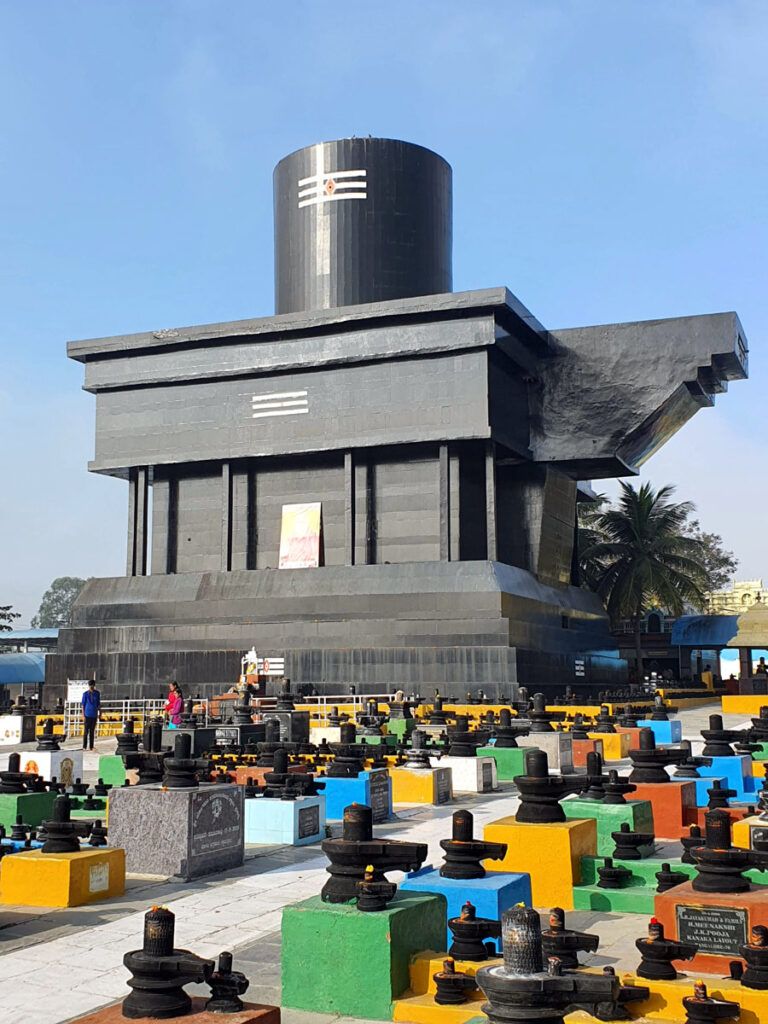
Contents
- 1 History of Kotilingeshwara Temple:
- 2 Legend of Kotilingeshwara Temple:
- 3 Significance of Kotilingeshwara Temple:
- 4 Myths of Kotilingeshwara Temple:
- 5 Architecture of Kotilingeshwara Temple:
- 6 Highlights of the Kotilingeshwara Temple architecture
- 7 Specialty of Kotilingeshwara Temple:
- 8 Kotilingeshwara Temple Timing:
- 9 Places to explore near Kotilingeshwara Temple:
- 10 FAQ:
- 11 How to reach Kotilingeshwara Temple, Kolar, Karnataka:
- 12 Google Maps:
History of Kotilingeshwara Temple:
Origin: The history of the Kotilingeshwara Temple dates back to the 1980s. It was initiated and developed by Swamiji, a local priest and devotee of Lord Shiva, along with the support of the local community. Swamiji had a vision to create a temple with a massive collection of Shiva Lingas, and this vision eventually led to the establishment of the temple complex.
Construction: The construction of the temple complex began in the 1980s and continued for several years. The temple boasts a large number of Shiva Lingas, and it’s said that the main Linga is the Kotilinga, representing one crore (ten million) Lingas. The temple’s architecture reflects traditional South Indian temple styles.
Record Collection: Over the years, the temple has amassed an incredible number of Shiva Lingas, both small and large, donated by devotees from across India and abroad. The collection includes various forms and sizes of Lingas, which are housed in separate shrines within the temple complex.
Religious Significance: The Kotilingeshwara Temple holds immense religious significance for devotees of Lord Shiva. It is believed that performing Abhishekam (ritual bathing) to the Kotilinga at this temple is highly meritorious, and it is said to fulfill devotees’ wishes and bring them blessings.
Annual Festivals: The temple celebrates various religious festivals, including Maha Shivaratri, which is one of the most significant festivals for Lord Shiva’s devotees. During this time, the temple attracts a large number of pilgrims and visitors.
Continued Development: The temple complex has continued to expand and develop over the years, with the construction of additional facilities for devotees, such as accommodation, a dining hall, and other amenities.
Read More>> Ujani Shaktipeeth Shri Mangal Chandi Temple
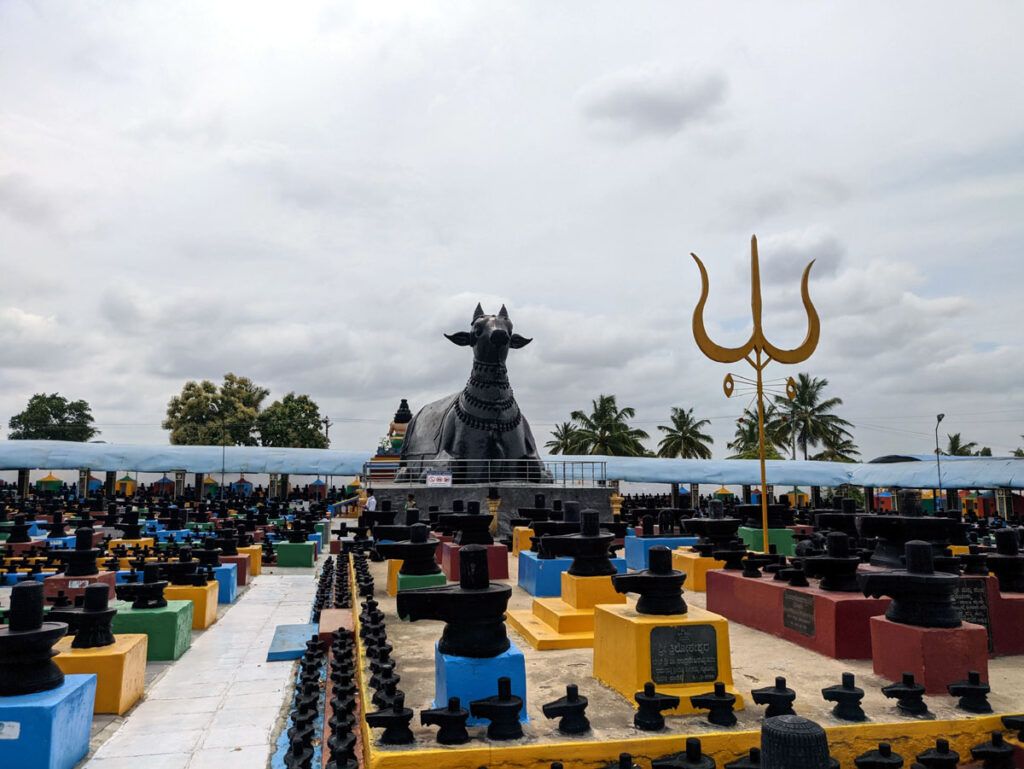
Legend of Kotilingeshwara Temple:
According to legend, the Kotilingeshwara Temple in Karnataka was established by a man named Manjunatha. Manjunatha was initially an atheist, but he had a sudden change of heart and became a devoted follower of Lord Shiva. He is said to have insulted Lord Shiva ten million times in his previous life, so he decided to create ten million Lingams (aniconic representations of Lord Shiva) to atone for his sins.
Manjunatha began his work by collecting stones from the surrounding area. He then carved each stone into a Lingam and placed it in a designated area. He worked tirelessly for many years, and eventually he was able to create ten million Lingams. The area where he placed the Lingams came to be known as Kotilingeshwara, which means “Lord of the Ten Million Lingams.”
One day, Manjunatha was visited by a group of sages. The sages were amazed by Manjunatha’s devotion to Lord Shiva, and they asked him how he had been able to create so many Lingams. Manjunatha told them that he had been helped by Lord Shiva himself. He said that Lord Shiva had appeared to him in a dream and given him the strength and perseverance to complete his task.
The sages were very impressed by Manjunatha’s story. They told him that he was a true devotee of Lord Shiva, and they blessed him with a long and happy life. Manjunatha continued to live at the Kotilingeshwara Temple for many years. He spent his days praying to Lord Shiva and helping other pilgrims.
The Kotilingeshwara Temple is now a popular pilgrimage site for Hindus from all over India. It is said that the Lingams at the temple are very powerful and that they can grant the wishes of devotees. The temple is also known for its beautiful architecture and its peaceful atmosphere.
Read More>> Badrinath Temple | Badrinarayan Temple
Here is another version of the legend:
According to another version of the legend, the Kotilingeshwara Temple was established by a man named Bhakta Manjunatha. Bhakta Manjunatha was a great devotee of Lord Shiva, but he was also very arrogant. He believed that he was the greatest devotee of Lord Shiva, and he often boasted about his devotion to others.
One day, Bhakta Manjunatha was visited by a wise old man. The old man asked Bhakta Manjunatha to prove his devotion to Lord Shiva. Bhakta Manjunatha was confident that he could do this, so he agreed.
The old man told Bhakta Manjunatha that he had to create ten million Lingams in order to prove his devotion. Bhakta Manjunatha accepted the challenge and began to work immediately.
Bhakta Manjunatha worked tirelessly for many years, but he was only able to create one million Lingams. He was starting to lose hope when Lord Shiva appeared to him in a dream. Lord Shiva told Bhakta Manjunatha that he was pleased with his devotion, and he granted him the power to create the remaining nine million Lingams.
Bhakta Manjunatha was overjoyed, and he quickly completed his task. He placed the ten million Lingams in a designated area, and the Kotilingeshwara Temple was born.
Read More>> Omkareshwar Jyotirlinga Temple: Lord of divine word “OM”
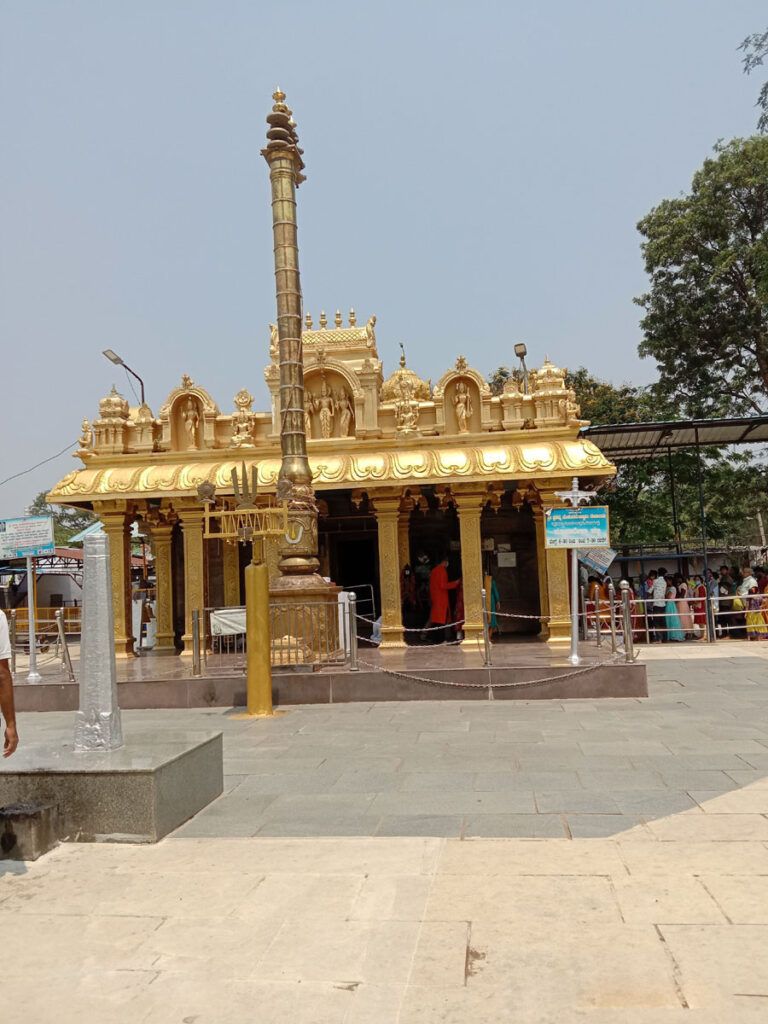
Significance of Kotilingeshwara Temple:
The Kotilingeshwara Temple in Karnataka is a significant Hindu pilgrimage site for a number of reasons:
- It is home to the tallest Shivalinga in Asia, measuring 108 feet (33 meters) tall.
- It is also home to over 90 lakh (9 million) smaller Shivalingas, spread over an area of 15 acres (61,000 square meters).
- The temple is believed to be over 1000 years old, but it was renovated and expanded in the 1980s by Swami Sambha Shiva Murthy.
- The temple is dedicated to Lord Shiva, one of the most revered deities in Hinduism.
- The temple is located in the village of Kammasandra, in the Kolar district of Karnataka. It is a popular tourist destination, and attracts millions of pilgrims from all over India and the world each year.
In addition to its religious significance, the Kotilingeshwara Temple is also a symbol of Hindu culture and heritage. The temple complex is home to a number of other shrines, including temples to Lord Brahma, Lord Vishnu, and other Hindu deities. The temple also has a museum that houses a collection of artifacts and sculptures related to Hindu culture.
The Kotilingeshwara Temple is a place where people of all faiths come together to pray, worship, and experience the power of spirituality. It is a truly unique and sacred place, and it is an honor to visit.
Here are some of the specific benefits that pilgrims and devotees derive from visiting the Kotilingeshwara Temple:
- It is believed that worshipping at the Kotilingeshwara Temple can help to fulfill one’s wishes and desires.
- The temple is also believed to be a place of great healing power. Many people have reported being cured of various ailments after visiting the temple.
- The Kotilingeshwara Temple is also a place of great spiritual significance. Many people come to the temple to meditate, to connect with their inner selves, and to experience the divine.
Read More>> Baidyanath Temple – Sacred Jyotirlinga with Location Dispute
Myths of Kotilingeshwara Temple:
There are a few myths associated with the Kotilingeshwara Temple in Karnataka, India.
The Myth of the Crore Lingas
One of the most popular myths is that the temple is home to a crore (10 million) lingas. The name “Kotilingeshwara” itself means “Lord of the Crore Lingas.” However, there is no historical evidence to support this claim. The temple actually has around 90 lakh (9 million) lingas.
The Myth of the Swayambhu Linga
Another myth is that the main linga in the temple is a swayambhu linga, meaning that it manifested itself on its own. This myth is based on the legend that the sage Gautama installed the linga at the temple site after being cursed by Indra. However, there is no geological evidence to support the claim that the linga is a swayambhu linga.
The Myth of the Wish-Fulfilling Lingas
Devotees believe that praying at the Kotilingeshwara Temple can help to fulfill their wishes. There are many stories of devotees whose wishes have been fulfilled after praying at the temple. For example, one story tells of a childless couple who were blessed with a child after praying at the temple.
The Myth of the Healing Lingas
Devotees also believe that the lingas at the Kotilingeshwara Temple have healing powers. There are many stories of people who have been cured of their illnesses after praying at the temple. For example, one story tells of a man who was cured of cancer after praying at the temple.
While these myths may not be scientifically proven, they are a testament to the faith and devotion of the devotees who visit the Kotilingeshwara Temple each year.
In addition to the myths mentioned above, there are also a few other myths associated with the Kotilingeshwara Temple, such as:
- The myth that the temple was built by the gods
- The myth that the temple is located on a sacred spot
- The myth that the temple is home to a number of hidden treasures
Read More>> Trimbakeshwar Jyotirlinga Temple
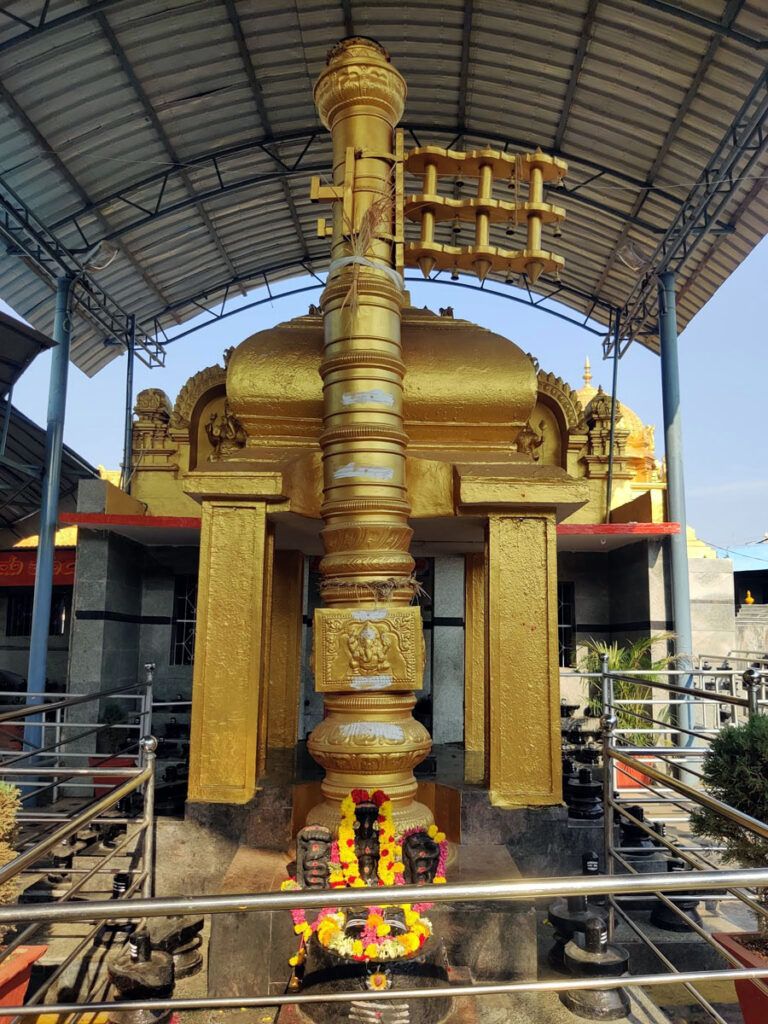
Architecture of Kotilingeshwara Temple:
The temple was constructed in the 1980s by Swami Sambha Shiva Murthy, a renowned spiritual leader and philanthropist. The temple architecture is a blend of Dravidian and Hoysala styles, with intricate carvings and sculptures depicting various Hindu deities and scenes from mythology.
The main entrance to the temple complex is a towering gopuram (gateway tower) with seven kalasams (finials). The temple complex also has a number of other shrines, including a Nandi temple, a Ganesha temple, and a temple dedicated to the goddess Annapoorneshwari.
The main sanctum sanctorum of the temple houses the 108-foot-tall Shivalinga. The Shivalinga is made of black granite and is surrounded by a water tank. Devotees can pour water over the Shivalinga to perform abhishekam (sacred bathing).
The temple complex also has a number of other interesting features, such as a meditation hall, a marriage hall, and a museum. The museum houses a collection of artifacts and sculptures from the Vijayanagara and Hoysala periods.
The Kotilingeshwara Temple is a popular pilgrimage site for Hindus from all over India and the world. The temple is also a popular tourist destination, due to its unique architecture and religious significance.
Read More>> Sri Siddhi Vinayaka Temple Secunderabad – Temple of Miracles
Highlights of the Kotilingeshwara Temple architecture
- The tallest Shivalinga in the world (108 feet / 33 m)
- Over 90 lakh (9 million) smaller Shivalingas spread over 15 acres (61,000 m2)
- A blend of Dravidian and Hoysala architectural styles
- Intricate carvings and sculptures depicting various Hindu deities and scenes from mythology
- A towering gopuram (gateway tower) with seven kalasams (finials)
- A number of other shrines, including a Nandi temple, a Ganesha temple, and a temple dedicated to the goddess Annapoorneshwari
- A meditation hall, a marriage hall, and a museum
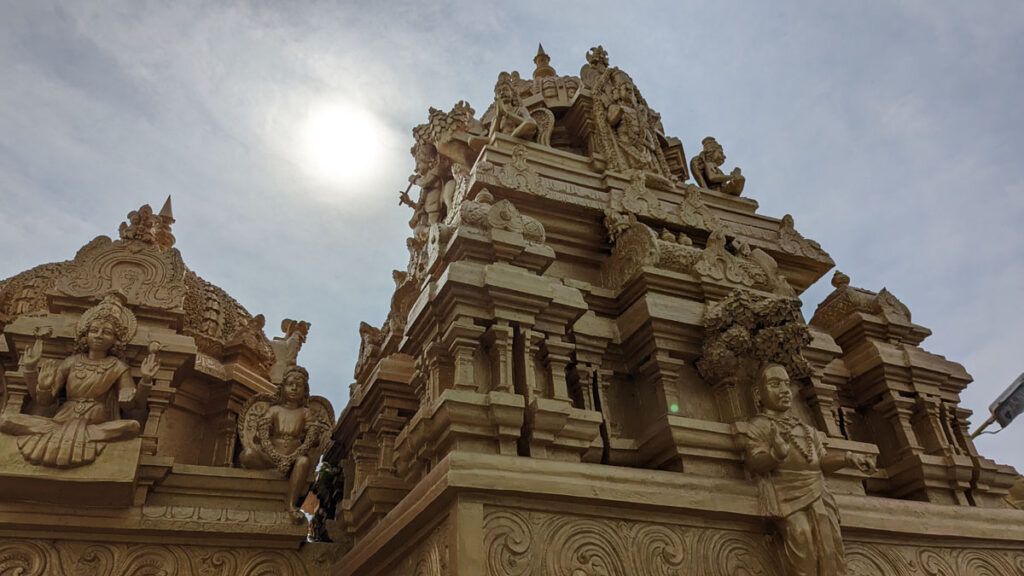
Specialty of Kotilingeshwara Temple:
- It has the largest and tallest linga in Asia. The linga is 33 meters (108 feet) tall and 35 meters (115 feet) in circumference.
- It has over 90 lakh (9 million) smaller lingas installed in its premises. This is why the temple is known as Kotilingeshwara, which means “one crore lingas.”
- It is one of the few temples in the world where devotees can perform abhishekam (sacred bath) on the linga with milk. This is a rare opportunity and is considered to be very auspicious.
- The temple is located in a beautiful and serene setting. It is surrounded by hills and forests, which makes it a perfect place for meditation and spiritual contemplation.
Kotilingeshwara Temple Timing:
- Morning: The temple typically opens around 6:00 AM in the morning.
- Evening: It remains open until around 8:00 PM or later in the evening, allowing visitors to have darshan (worship and viewing of the deities) throughout the day.
Places to explore near Kotilingeshwara Temple:
Anthargange: Anthargange is a hilly area and a popular trekking destination. It’s known for its unique rock formations and caves. The Anthargange temple is also a significant religious site.
Kolar: Kolar town, the district headquarters, has historical and cultural significance. You can visit the Kolaramma Temple, Someshwara Temple, and the Kolar Gold Fields, known for their gold mines.
Avani: Avani is a small town near Kolar, known for the Sita temple and the Valmiki Ashram. It’s believed to be the birthplace of Lava and Kusha, the sons of Lord Rama and Sita.
Nandi Hills: Nandi Hills is a beautiful hill station about 60 kilometers from Kotilingeshwara. It offers panoramic views of the surrounding landscape and has historical forts and temples.
Shivagange: Shivagange is another popular pilgrimage and trekking destination known for its natural rock formations and the Gangadhareshwara Temple.
Kaiwara: Kaiwara is a small town with religious significance. You can visit the Tapovan caves where Swami Vivekananda meditated. There’s also a temple dedicated to Lord Parshurama.
Lepakshi: Lepakshi is famous for the Veerabhadra Temple, a 16th-century marvel with intricate carvings. It’s about a two-hour drive from Kotilingeshwara.
Horsley Hills: Horsley Hills is a hill station in Andhra Pradesh, known for its cool climate and lush greenery. It’s a serene place to relax and enjoy nature.
Chikballapur: The district headquarters, Chikballapur, is known for its historical and religious sites, including the Bhoga Nandeeshwara Temple and the Bhimeshwara Temple.
Vidurashwatha: Vidurashwatha is a sacred fig tree located near Lepakshi. It’s believed to be the spot where Vidura, a character from the Mahabharata, is said to have interacted with Lord Krishna.
To visit more temples check Karnataka Tourism Website.
FAQ:
Q: Where is Kotilingeshwara Temple located?
A: Kotilingeshwara Temple is located in the town of Kolar, Karnataka, India. It is about 70 km from Bangalore, the capital of Karnataka.
Q: When was Kotilingeshwara Temple built?
A: Kotilingeshwara Temple is believed to have been built in the 12th century by the Chola king Raja Raja Chola I. However, there is also evidence to suggest that the temple may have existed even earlier.
Q: What is the significance of Kotilingeshwara Temple?
A: Kotilingeshwara Temple is one of the most important Shiva temples in Karnataka. It is believed to be the place where the sage Agastya installed a sacred lingam (aniconic representation of Shiva) to worship. The temple is also known for its unique architecture, which is a blend of Dravidian and Hoysala styles.
Q: What are the main attractions of Kotilingeshwara Temple?
A: The main attractions of Kotilingeshwara Temple are the following:
- The main lingam: The main lingam of the temple is believed to be one of the most sacred lingams in India. It is said to be self-manifested (swayambhu) and is worshipped by millions of devotees every year.
- The Nandi statue: The Nandi statue at Kotilingeshwara Temple is one of the largest Nandi statues in India. It is carved out of a single block of granite and is said to be over 1000 years old.
- The temple architecture: The temple architecture is a unique blend of Dravidian and Hoysala styles. The temple complex has a number of intricately carved sculptures and panels that depict various scenes from Hindu mythology.
Q: What are the best times to visit Kotilingeshwara Temple?
A: The best times to visit Kotilingeshwara Temple are during the winter months (October to March), when the weather is pleasant. The temple is also open during the summer months (April to June), but the weather can be quite hot and humid.
Q: Are there any special festivals celebrated at Kotilingeshwara Temple?
A: Yes, there are a number of special festivals celebrated at Kotilingeshwara Temple throughout the year. Some of the most important festivals include:
- Mahashivaratri: This festival is celebrated in February or March and is one of the most important Hindu festivals. On this day, devotees worship Lord Shiva and stay up all night chanting his mantras.
- Karthika Somavara: This festival is celebrated on Mondays in the Hindu month of Karthika (October-November). On this day, devotees worship Lord Shiva and bathe in the holy tank of the temple.
- Hanuman Jayanti: This festival is celebrated in April and commemorates the birth of Lord Hanuman. On this day, devotees worship Lord Hanuman and offer him sweets and flowers.
Q: Are there any accommodation options available near Kotilingeshwara Temple?
A: Yes, there are a number of accommodation options available near Kotilingeshwara Temple, ranging from budget hotels to luxury resorts. There are also a number of guesthouses and dharamshalas (pilgrim guesthouses) run by the temple authorities.
Q: How to get to Kotilingeshwara Temple?
A: Kotilingeshwara Temple is well-connected to Bangalore and other major cities in Karnataka by road and rail. There are regular buses and trains that ply between Bangalore and Kolar. Once you reach Kolar, you can take a taxi or auto-rickshaw to the temple.
How to reach Kotilingeshwara Temple, Kolar, Karnataka:
By Air:
The nearest major airport to Kotilingeshwara Temple is Kempegowda International Airport (BLR) in Bengaluru, which is approximately 75-80 kilometers away. Once you arrive at the airport, you can hire a taxi or use other transportation options to reach the temple.
By Train:
The nearest railway station to Kotilingeshwara Temple is the Kolar Railway Station, which is about 15-20 kilometers away. You can take a train to Kolar from Bengaluru or other major cities in the region and then hire a taxi or use local transportation to reach the temple.
By Road:
Kotilingeshwara Temple is well-connected by road, and you can reach it by car or bus. Here are some common routes:
From Bengaluru: Kotilingeshwara Temple is approximately 80 kilometers from Bengaluru. You can take the NH75 (Bengaluru-Tirupati Highway) and drive towards Kolar. After reaching Kolar, you can follow the signs to reach the temple, which is about 15-20 kilometers from the city.
From Chennai: If you are coming from Chennai, you can take the NH75 and head towards Kolar. Once in Kolar, follow the signs to reach the temple.
Local Transportation:
Once you reach the vicinity of Kotilingeshwara Temple, you can hire a local auto-rickshaw, taxi, or use your own vehicle to reach the temple premises. The temple is known for its vast expanse of Shiva lingams, and you’ll have to walk around the temple complex to see the various installations.
